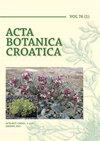紫锥菊真菌多样性及离体共生萌发
IF 0.7
4区 生物学
Q3 PLANT SCIENCES
引用次数: 4
摘要
通过有效的种子萌发和幼苗生长方法,兰花的保护是可能的。在这种情况下,兰花种子的离体共生萌发和幼苗生长可能是方便和有利的。在本研究中,研究了山葵(Serapias vomeracea)根部内生真菌的多样性。Briq。揭示了这些真菌对种子萌发、幼苗发育和块茎形成的离体影响。在2年的时间里,每个月从鸢尾根中分离出真菌,并根据其形态特征和核糖体DNA (rDNA)内转录间隔区(ITS)序列进行鉴定。所有加入菌根菌群的根丝胞菌样分离株均与calospora toulasnella(30株)亲缘关系密切。非根核菌分离株与枯萎菌(2株)、尖曲霉(1株)和嗜松Talaromyces pinophilus (Pezizales)(1株)密切相关。种子存活率为90.32%。将种子包放置在含真菌的土壤中,观察其萌发过程。所有与黄孢土拉菌相关的分离株均能促进萌发和幼苗发育。分离物Svl 21 (Tulasnella sp.)的发芽率最高(98%),而分离物Svl 4发育出叶片先进的幼苗(第4期(S4):叶片先进和/或生根的幼苗,13.67%)。S4的幼苗全部转移到自然环境中;第一批块茎在7个月后被观察到。本研究首次研究了欧洲块茎兰花(S. vomeracea)在自然环境下从种子到成株的发育过程。本文章由计算机程序翻译,如有差异,请以英文原文为准。
Fungal diversity and ex vitro symbiotic germination
of Serapias vomeracea (Orchidaceae)
Conservation of orchids can be possible with effective seed germination and seedling growth methods. In this context, ex vitro symbiotic seed germination and seedling growth of orchid seeds may be convenient and advantageous. In this study, both the diversity of the root endophytic fungi in Serapias vomeracea (Burm.f.) Briq. and the ex vitro effects of these fungi on seed germination, seedling development and tuber formation were revealed. The fungi were isolated monthly for two years from S. vomeracea roots and the isolates were identified based on morphological characters and internal transcribed spacer (ITS) region of
nuclear ribosomal DNA (rDNA) sequences. All of the Rhizoctonia-like isolates that joined the mycorrhizal association were closely related to
Tulasnella calospora (thirty isolates). Non-Rhizoctonia isolates are closely related to Fusarium tricinctum (two isolates), Aspergillus spelaeus (one isolate) and Talaromyces pinophilus (Pezizales) (one isolate). The viability rate of the seeds was 90.32%. The seed packs were placed in soils containing fungus and the germination process was followed. All isolates associated with Tulasnella calospora promoted germination and seedling development. Isolate Svl 21 (Tulasnella sp.) was found to have the highest germination rate (98%) but isolate Svl 4 developed seedlings with advanced leaves (stage 4 (S4): seedlings with advanced leaves and/or rooted, 13.67%). All seedlings at S4 were transferred to the natural environment; the first tubers were observed seven months after. In this study, for the first time, a tuberous European orchid, S. vomeracea developed from seed to adult plant in a natural environment.
求助全文
通过发布文献求助,成功后即可免费获取论文全文。
去求助
来源期刊

Acta Botanica Croatica
PLANT SCIENCES-
CiteScore
2.50
自引率
0.00%
发文量
34
审稿时长
>12 weeks
期刊介绍:
The interest of the journal is field (terrestrial and aquatic) and experimental botany (including microorganisms, plant viruses, bacteria, unicellular algae), from subcellular level to ecosystems. The attention of the Journal is aimed to the research of karstic areas of the southern Europe, karstic waters and the Adriatic Sea (Mediterranean).
 求助内容:
求助内容: 应助结果提醒方式:
应助结果提醒方式:


